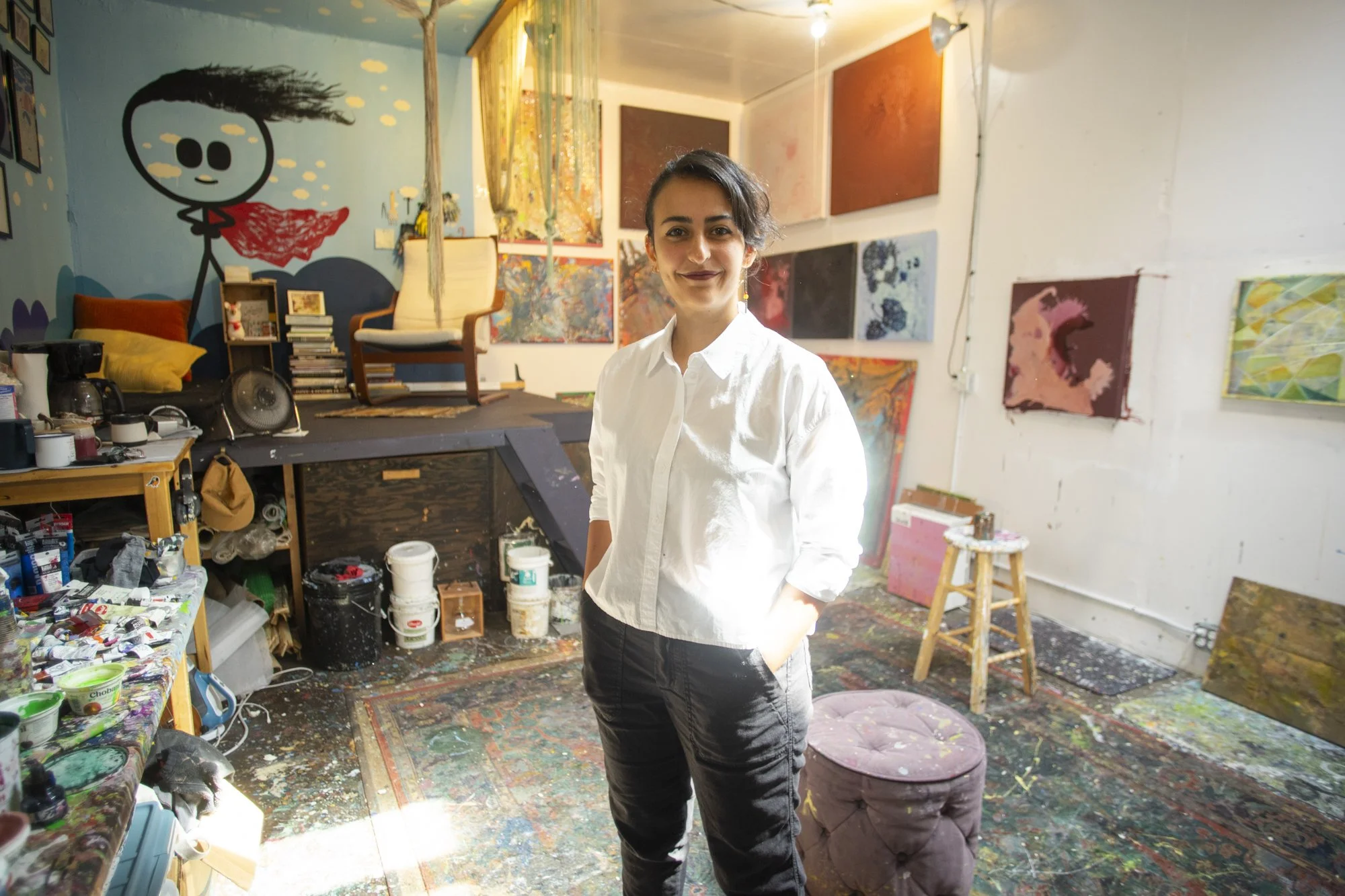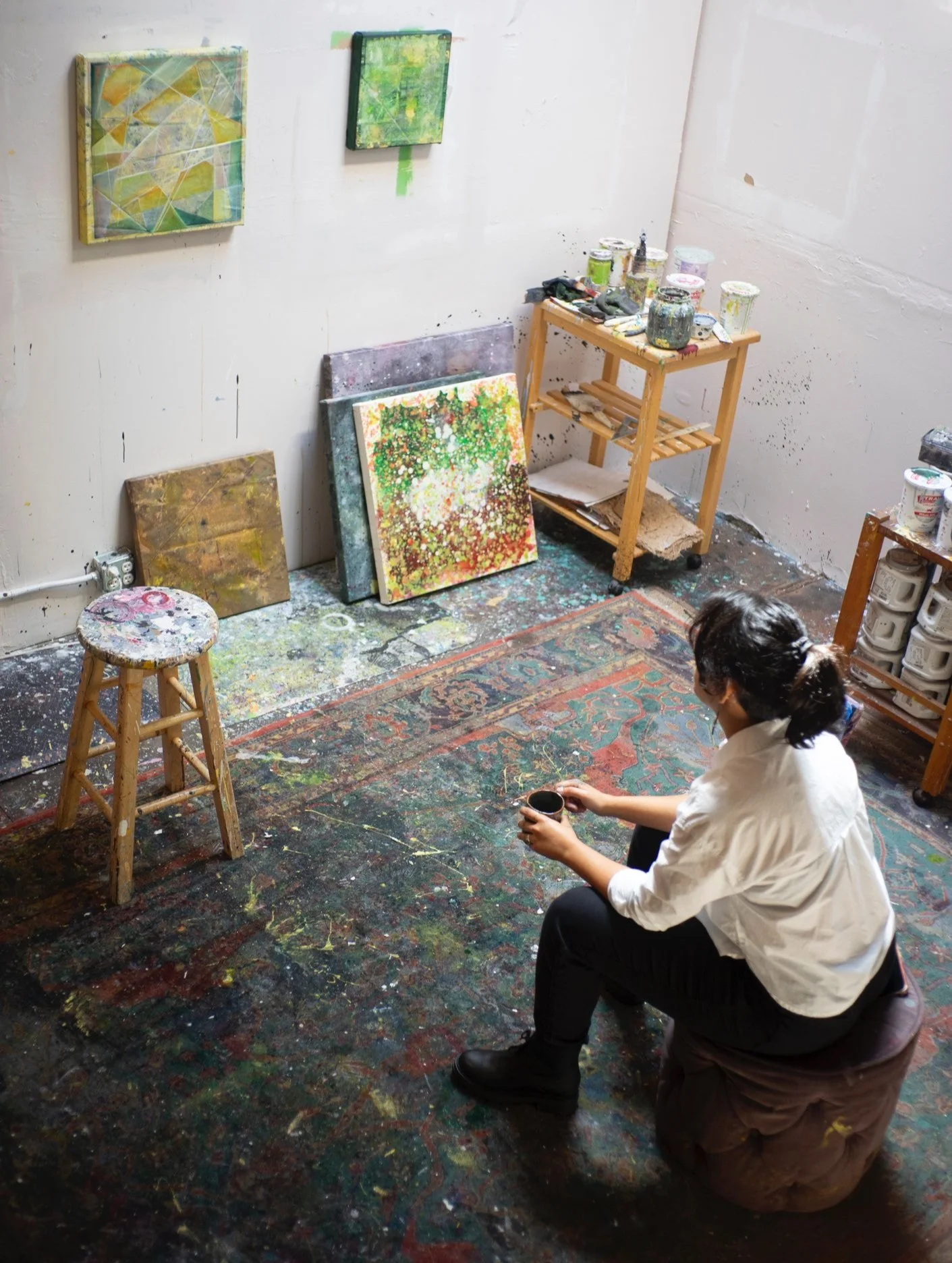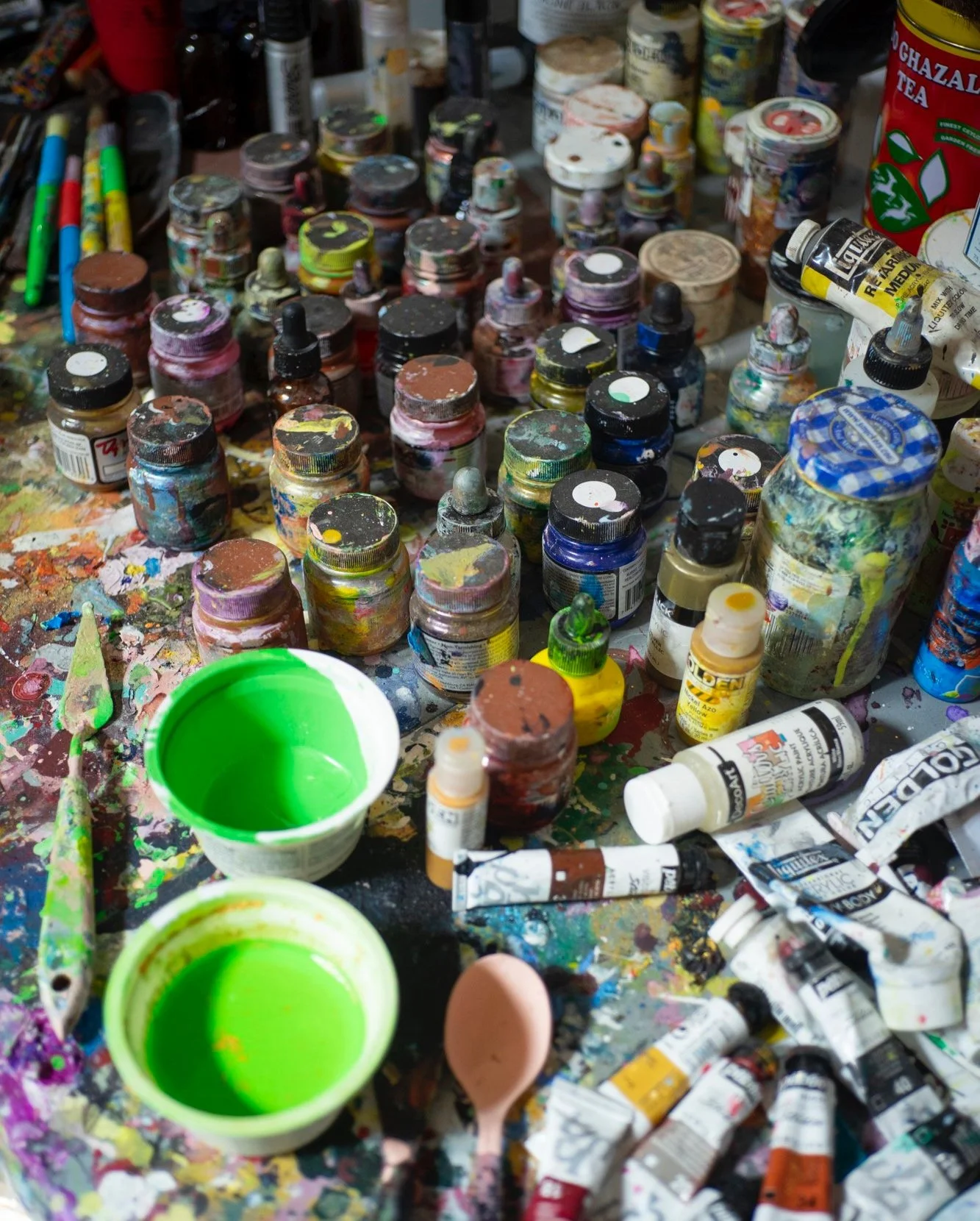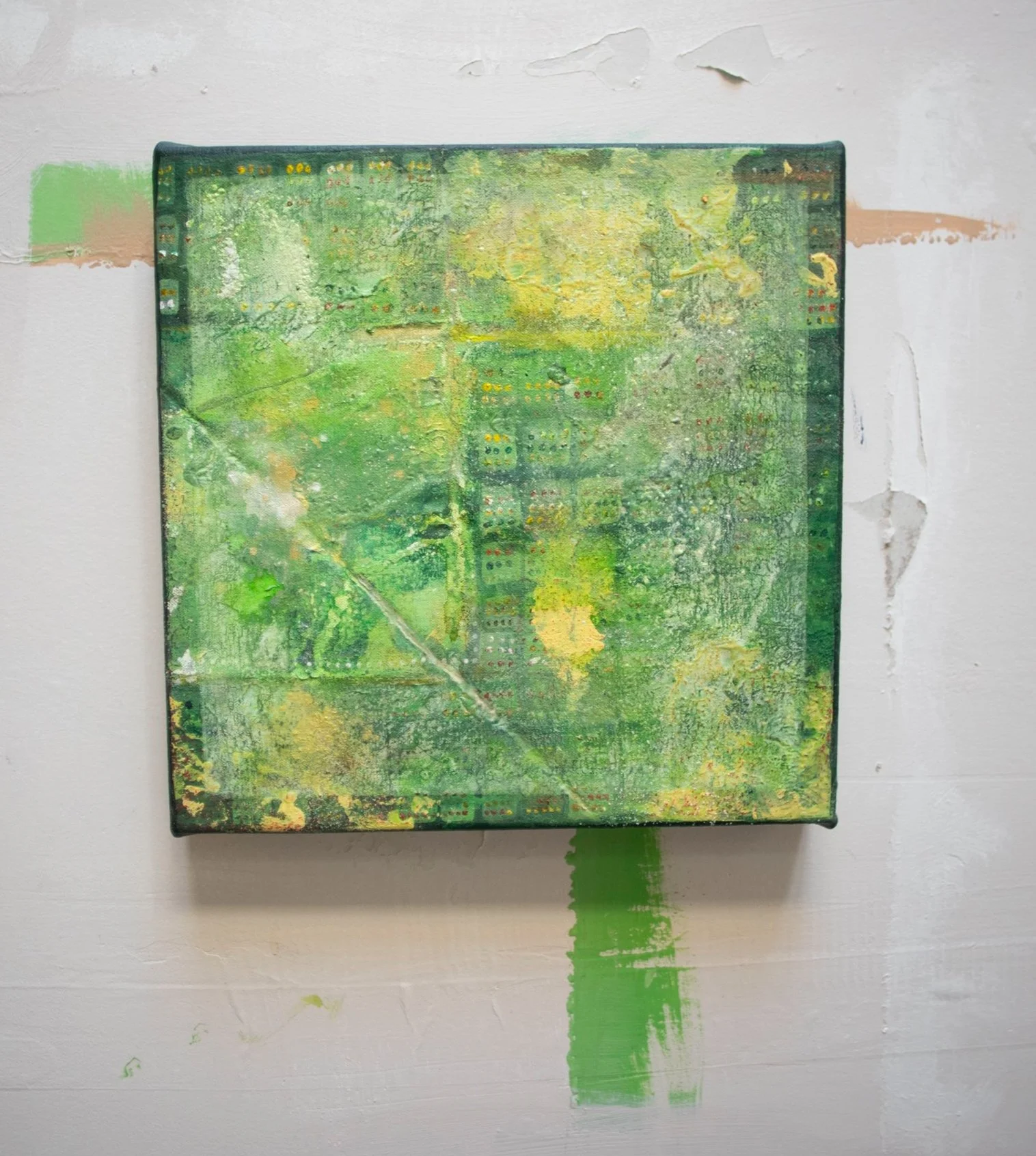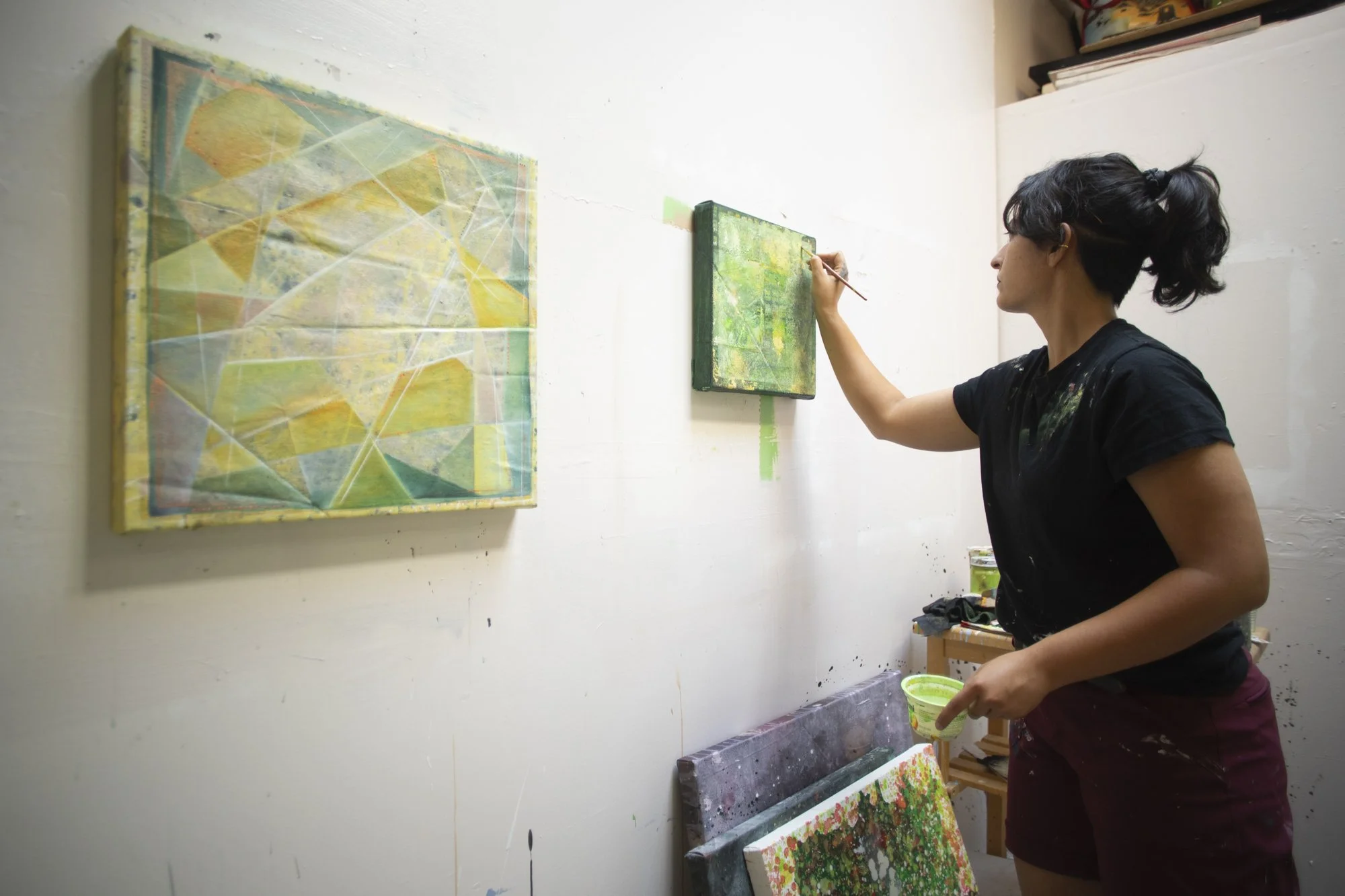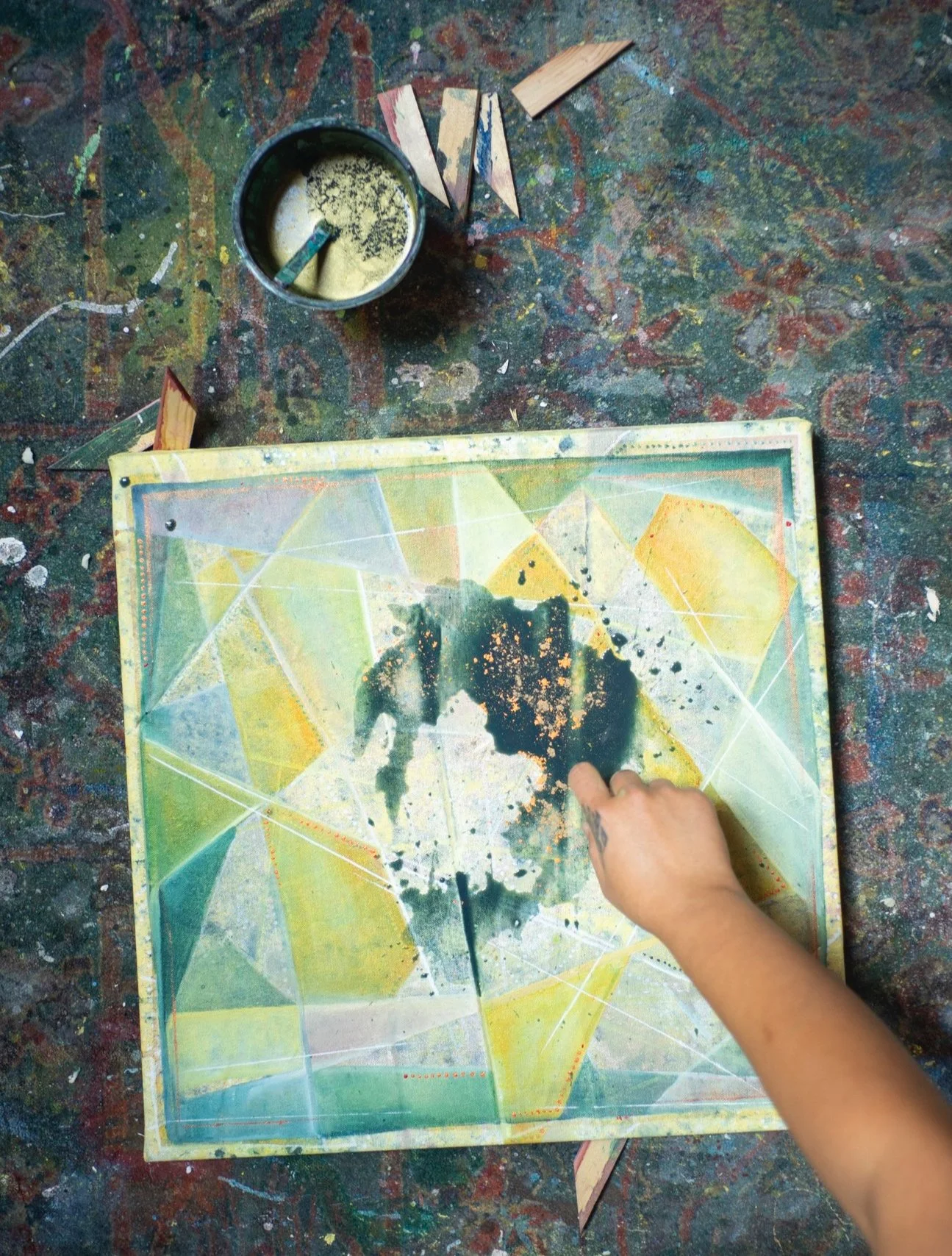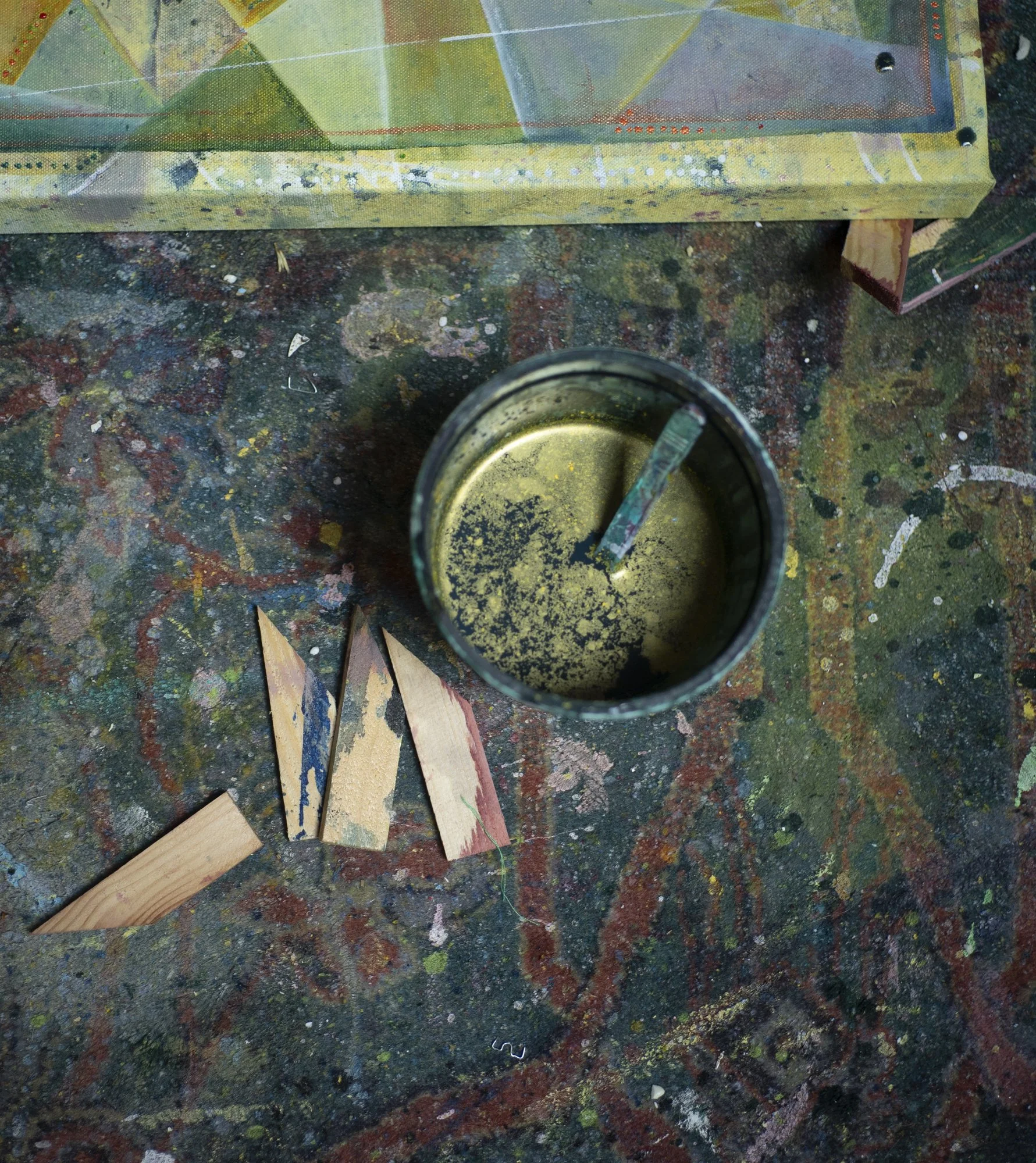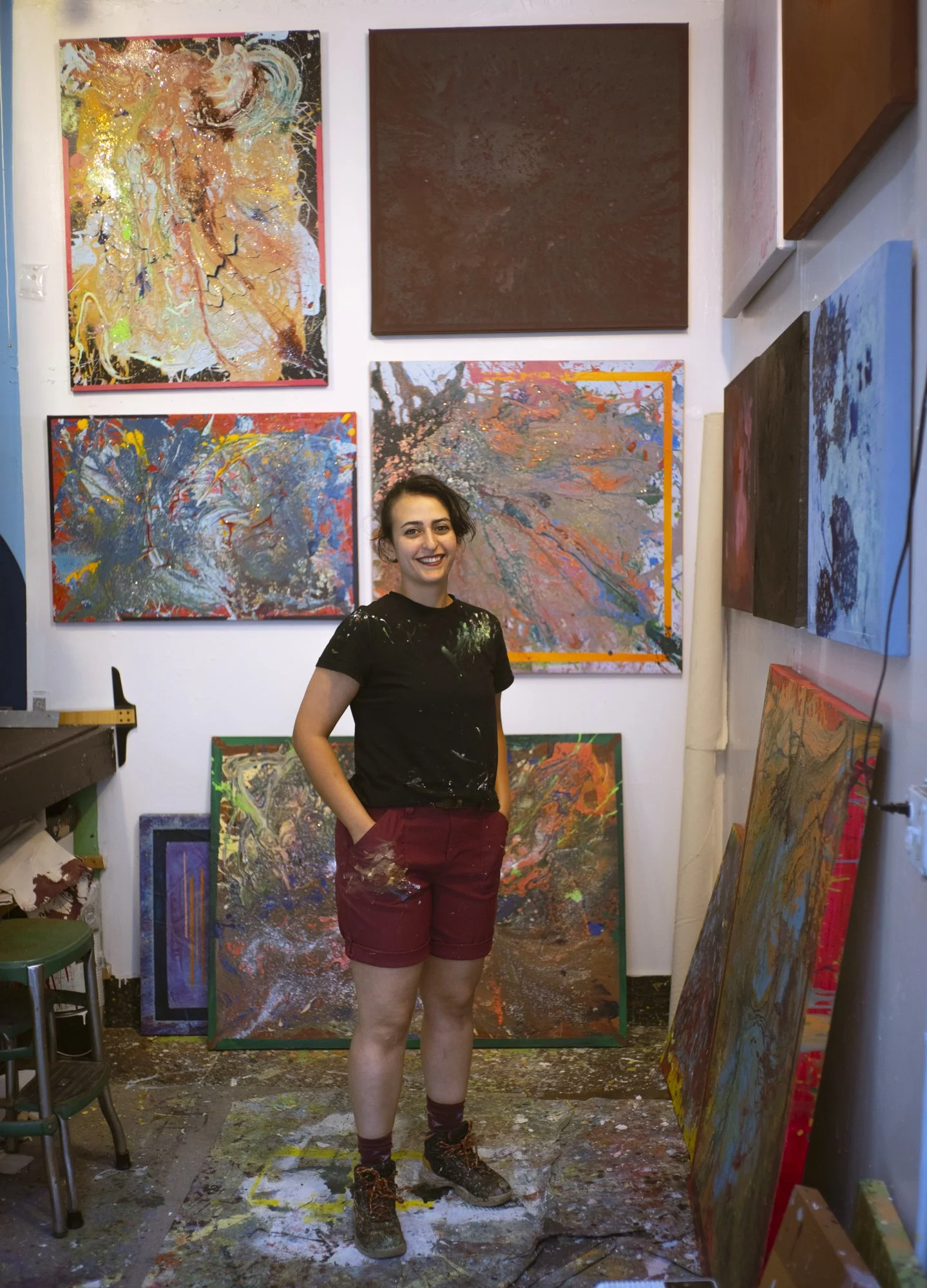Studio Visit & Interview With Termeh Behbahani
Interview and Photography by Brandon Joseph Baker
In a cozy artist warehouse at the edge of The Mission District, in one of the numerous points where San Bruno Ave is interrupted with an overpass of the 101, I met Termeh Behbahani pouring color on canvases in her studio. Behbahani’s studio is quaint, a skylight illuminates the room, the walls are lined floor to ceiling with finished art, works in progress, paint and mixers for paint, splatters of paint on the floor and a lofted nook where she decompresses. Behbahani offers coffee and we set out to discuss her practice as an abstract studio artist and a muralist. Her two styles of work are vastly different in approach and aesthetic but the core of her process remains consistent, finding control and herself within the color.
Behbahani begins her abstractions with two knowns: the size of the canvas and a vision of color. The rest of her painting process is an exercise in guiding and problem solving the transformation of the color. Working primarily with ink and powdered pigment, Behbahani enjoys controlling the mixing process and embraces the unknown transformations of the paint once poured on the canvas. Behbahani folds some canvases before pouring paint to encourage texture and to facilitate space for the color to pool and morph or dry and crack. The artist’s hand is most evident in mixing color yet continues to guide with careful restraint and calculated embellishments using brushes, finger tips or breathing air across a pool of ink.
Behbahani begins her mural work similarly with scale and size. In her abstractions choice of color creates a playground for control but her public art is driven by messages and symbols that read quickly. One recurring symbol, a stick figure named Termnator which also adorns the wall of her studio, has expressive hair reflective of the artist’s self and wears a cape amplifying Behbahani's belief that everyone should be the hero of their own story. Messaging is a driving element in Behbahani’s mural work and her emphasis is to engage the audience while staying true to the client’s vision.
Interview
Thank you for taking the time to meet with me in your studio. When you get to the studio, what is the first thing you do when you get started?
Thank you for being here and for giving me a chance to talk about my art practice. I have found that I need to take time to get acclimated to the energy of my studio. It takes about 15 minutes or so for me to get over the excitement of being in my studio and the excitement I have that comes with painting. After I have settled, I look around and see which piece requires my attention that day. At times certain paintings do not look welcoming to me and I have to turn them around to stop myself from obsessing over them. Intuition plays an important role in my practice. Once I determine which piece requires my attention, I stare at it for a good while until I know what needs to be done and then I start.
You use ink and pigment powder in your paintings, what about these materials resonates most with you and how do you use them in your art?
I love using ink because it is so unpredictable in how it dries. I play with the idea of control a lot in my practice. Having control over what color I am mixing and giving up control of knowing how it is going to dry is a big part of my work. I’m constantly walking that line and exercising what I do and do not have control over. Adding powdered pigment to my paint while I am mixing is an unpredictable element. Most powdered pigments don’t mix well with water, so the powder sits on top, and once it is applied to the canvas it either blends through the canvas thread and adds a shine to the paint or stays on top of the canvas as clumps of powder and creates texture. My absolute favorite effect is when it mixes with the paint and adds that shine to the color once applied; but it is so subtle that the viewer has a tough time identifying the effect. Subtlety is important to me.
Folding a canvas is a unique choice to begin a painting, how did you get to that process and where has it taken your craft?
It all started as a mistake! I used to start each piece with heavy pours of transparent paint. One day I over-poured and was quite upset thinking I’d ruined my piece. I folded it and threw it to the side so I would not have to look at it. After a while I decided to give it another shot and was pleasantly surprised at the effects I got after unfolding it. Since then, I have been practicing with different methods and variations of transparency to get closer to my desired effect when I fold. It has become sacred to me and my practice. It is also my favorite part of painting.
You likened your process to solving a puzzle or sorting out the puzzle pieces, how does problem solving come into play with an artistic style which relies heavily on mixing, pouring and drying paint?
I like to think that I can see a glimpse of my finished pieces in my mind before starting them. I believe that is where my intuition is guiding me, like a dream that I can’t remember. In that sense I see them as puzzles. Color and pouring paint are all different pieces of the puzzle. It is about deciding which piece is needed when and how they fit together. It’s a very abstract concept because I never know how a painting is going to turn out when I start it, and yet when it is finished, I feel as if I have seen it before.
There are two different styles of paintings on your wall: one with multiple bright colors, splatters of paint, cracked and peeling paint all covered in glitter, the other style is more calculated, monochromatic and subdued. What inspired the change between these two styles?
I am always asking myself the same question. I think there are a lot of different factors that affect the different periods of my art practice. Looking back I know I was going through a period of personal discovery when I was creating the glitter paintings. I had a lot of doubt and didn’t have a lot of trust in the world around me. I was heavily experimenting with my paintings and was desperate to create a specific image I had in my mind. The whole series was based on this idea of the images we see when we rub our eyes with our hands. I wanted to recreate that. I find it interesting that I was spending a lot of time rubbing my eyes, to the point that I felt the need to recreate it. There is something to be said about that.
The paintings that came after are much more mature. I was in a much happier place with myself and my life. I felt more secure in who I was and through that learned to trust the world again. I think that is how the monochromatic paintings came to life. I was done experimenting and wanted to refine everything I had learned. I almost wanted to create the peaceful images that existed in my brain and help validate for myself the overall happiness I felt in my life.
I enjoy the visual change that came from that overall happiness you feel. You strive to be an honest painter, how do you stay honest with painting in abstractions?
A huge part of painting is decision making and I always try to make every decision from an honest and true place. Abstract painting is no different. Working primarily with color and composition it's important to be sure of your choices. It’s also important to be honest with yourself when painting. If I know I have reached my limit in the day then I know I might make decisions because I'm too tired and that usually doesn’t give me a good result. Checking in with myself is key, so I always do my best to stay on top of how I’m feeling in each painting session.
Your education began in mechanical engineering, what drove your decision to switch to study art and how does your current practice reflect your earlier education?
I was never excited about mechanical engineering, it felt more of a chore I had to do than anything else. When I first moved to the U.S I went to a community college and that gave me the opportunity to try different classes. I told myself I will try a painting class since I had always loved painting as a kid. I knew something was different when I was excited to go home and work on my homework. I had never been excited to do homework. All aspects of painting intrigued me and I wanted to learn everything I could about it. I never felt bored or forced to paint.
Looking back at my earlier work now I know there are certain geometric elements I used subconsciously that refer to my background in math. Even now there are elements to my work that give my abstract pieces a structure that my audience is more aware of than I am. Our backgrounds are always a part of us.
Working in two different realms of painting, murals and studio fine art, you have two very different processes; what is similar with the two ways you work and what is vastly different?
I would say the biggest difference is in the process of painting. When working on a mural I rely less on intuition and make sure that I have thought and planned out all parts of the design before actually starting the painting. In my studio practice I start with a basic idea of my color scheme and work intuitively with each layer from there. Public art and murals also need to be more direct and accessible whereas with a painting your audience has the opportunity to spend time looking at your piece and as an artist you want to create an engaging piece of art. As a result, I tend to be more abstract with my concept and message.
I would say in terms of similarities, it’s important to note that both styles are still me. I find comfort in knowing that I can reach a wider audience with my public art practice.
You completed your ‘Free Iran’ mural on Hayes street in 2023, as an Iranian woman living in California, what did you learn through this project?
I was in Iran in September 2022 when the Woman, Life, Freedom revolution started. It was a hard experience for me even though I was physically safe. When I returned to San Francisco in October while the riots were happening in Iran I had a hard time with the lack of coverage and lack of knowledge about what is going on in Iran. I knew I had to do something. I decided to paint a mural to raise awareness for the Woman of Iran. I remember seeing young women walking down Divisadero Street as I was painting, enjoying their day and all I could think of was how I needed them to know that the simple act of walking in shorts with their hair around their shoulders is a crime in Iran and the punishment is worse than they can imagine. I had a lot of good conversations with people during the painting of that mural. I hope after someone sees the mural they won’t scroll away when they see a news update about Iran on their phone.
You grew up in Iran, how is being an artist in California, specifically in San Francisco, different from being an artist in Iran? Are there any cultural influences you carry over from your life in Iran?
I haven’t had the experience of being a fine artist in Iran yet. I studied math while I still lived in Tehran, Iran and only started painting once I moved to the U.S, but it is a dream of mine to be able to show my work in Iran and share my work there. Growing up in Iran, a place with such a rich history in all aspects of culture such as poetry, architecture, painting, traditions and so on has turned my “artistic compass” to a different north as I like to say. A single line of Persian poetry can be interpreted in so many different ways and I am aware of how that has been engraved in me. Same with the intricate and vibrant colors in traditional Persian architecture. Being surrounded and educated in that environment has allowed me to look at my art with a different lens and expectation of what I want my art to be.
You are in a group show at Moth Belly Gallery which opened October 3rd. What are you most excited about showing with this group and what have you learned from your experiences in your art community?
I am honored to be part of this show alongside so many amazing artists. I am grateful to call them friends. We all come from different backgrounds and styles of art yet our work meshes well together. I always find that fascinating, it shows the beauty and power of art. It’s important to have a community that hosts all kinds of artists. I find value in talking to artists that have very different practices than I do. It’s important to train our eyes and for me one of the best ways to achieve that is through looking at a wide range of art.
What is next for you, anything you’re working on that you’re excited to talk about?
I will be moving to LA in the next few months to expand on my career as an artist and muralist. I’m excited to explore the art market there and see where it takes me.
